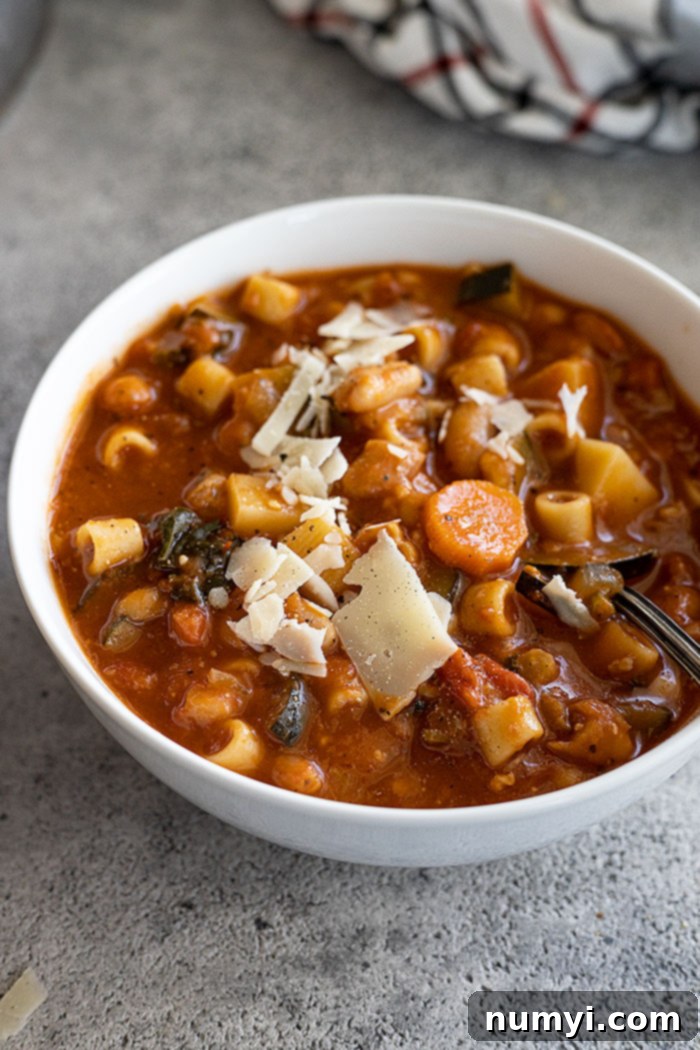The Best Homemade Minestrone Soup: An Easy & Healthy Recipe (Better Than Olive Garden!)
Warm up with a bowl of this incredible homemade Minestrone Soup! Bursting with colorful, nutritious vegetables, fragrant herbs, and a robust tomato broth, this recipe is perfect for using up pantry staples and any leftover veggies you have on hand. Forget the restaurant; this easy, healthy, and budget-friendly version is truly the best!
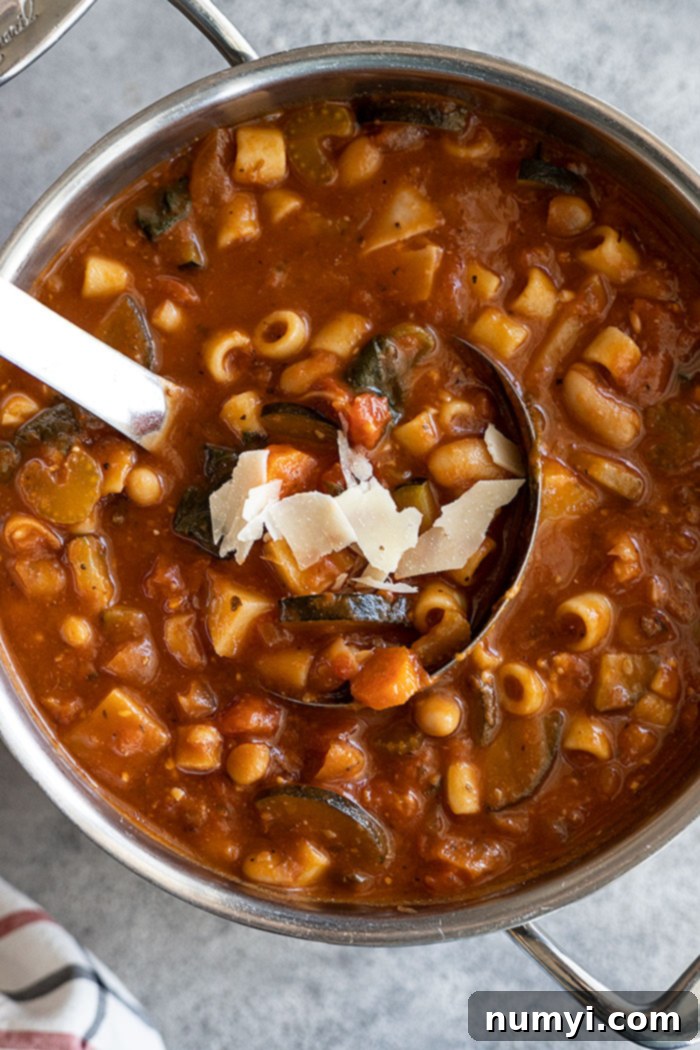
If you haven’t yet experienced the pure comfort and convenience of making a big pot of homemade minestrone soup, you are truly missing out! It’s not just a meal; it’s an experience—a vibrant, hearty, and incredibly satisfying dish that can easily become your go-to weeknight dinner. The beauty of minestrone lies in its versatility: you can literally throw in any vegetables you have in your refrigerator or pantry. This flexibility means fewer trips to the grocery store and more delicious, waste-free cooking right in your own kitchen.
Beyond its incredible flavor, this minestrone recipe is also a fantastic choice for those looking for nourishing, wholesome meals. It’s naturally vegetarian, packed with fiber and vitamins, and incredibly adaptable to various dietary needs. Whether you’re a seasoned cook or a beginner, you’ll find this recipe straightforward and rewarding. It’s the kind of comforting soup that tastes even better the next day, making it ideal for meal prepping or enjoying throughout the week.
For those chilly evenings when you crave a warm, hearty bowl of goodness, minestrone is always a winner. And if you’re looking to explore other comforting soup options using simple pantry staples, be sure to try this delightful Creamy Potato Soup—it’s both rich and incredibly satisfying! Or perhaps you’re in the mood for something with a bit more robust texture, leaning towards a stew? Our Green Chile Stew or a classic Hearty Beef Stew are excellent choices, perfect for warming you from the inside out on the coldest of nights.
At its heart, minestrone soup is a traditional Italian vegetable soup, renowned for its rich tomato broth, aromatic herbs, and the inclusion of pasta or rice, along with a medley of fresh or leftover vegetables. Historically, it was a “cucina povera” dish, meaning “poor kitchen” food, designed to be economical and make the most of whatever ingredients were available. This heritage is what makes minestrone such a practical and delicious choice for modern home cooks – it’s a celebration of seasonal produce and smart cooking, ensuring no vegetable goes to waste.
Why You’ll Love This Homemade Minestrone Soup Recipe
- A Truly Hearty Vegetarian Soup: This isn’t just a side dish; it’s a full meal in a bowl, packed with wholesome ingredients that will leave you feeling completely satisfied.
- Effortless to Make & Budget-Friendly: With simple ingredients and straightforward steps, this recipe is perfect for busy weeknights and won’t break the bank. It leverages inexpensive produce and pantry staples.
- Healthy, Warm, and Wholesome: Loaded with a variety of vegetables, beans, and whole grains (pasta), it’s a nutrient-dense option that nourishes your body and soul.
- Highly Adaptable: Whether you need to use up specific vegetables, cater to dietary restrictions, or simply prefer certain ingredients, this recipe is incredibly forgiving and easy to customize.
- Freezer Friendly & Amazing Leftovers: Make a big batch and enjoy it for days! It freezes beautifully, making future meal times even easier.
- Hands Down, Better Than Olive Garden Minestrone Soup: While Olive Garden’s version is popular, this homemade recipe offers fresher flavors, superior texture, and allows you to control the quality of ingredients, resulting in a more authentic and delicious experience.
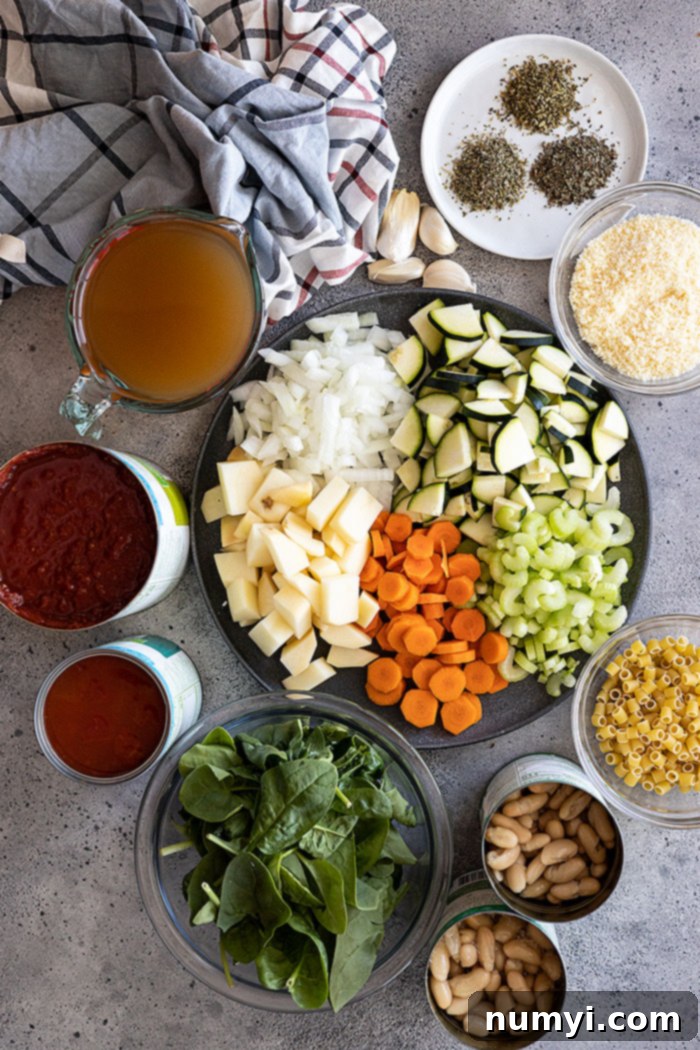
Key Ingredients for Flavorful Minestrone Vegetable Soup
Creating a truly outstanding minestrone starts with understanding the role of each ingredient. While flexibility is key, these components form the backbone of a delicious and satisfying soup:
ONIONS, CELERY, CARROT: These three humble vegetables form what Italians call a “soffritto.” This aromatic base is gently sautéed to release incredible foundational flavors, creating a sweet and savory depth that is essential for a rich soup. Don’t rush this step; properly caramelizing these vegetables is critical for the soup’s overall taste.
GARLIC: Another powerhouse of flavor, minced garlic adds a pungent, savory kick that complements the soffritto beautifully. It’s crucial to add the garlic towards the end of the soffritto cooking to prevent it from burning, which can turn its wonderful aroma bitter. The combination of soffritto and garlic truly defines the characteristic taste of this soup.
ASSORTED VEGETABLES: For this particular recipe, I’m featuring zucchini, potato, and fresh spinach. These were chosen because they’re common, readily available, and create a great balance of textures and nutrients. However, as emphasized earlier, this is where your creativity shines! Feel free to incorporate any vegetables you have on hand – think green beans, kale, bell peppers, corn, sweet potatoes, or even small florets of broccoli or cauliflower. The aim is to clean out your fridge and let no good produce go to waste!
TOMATOES: To achieve a rich, well-rounded tomato base with satisfying texture, I’m using both crushed tomatoes for body and diced tomatoes for chunky bits of fruit. This combination provides a delightful contrast and depth of tomato flavor, which is a cornerstone of classic minestrone.
BROTH: To ensure this remains a delightful vegetarian soup, high-quality vegetable broth is my choice. Opt for a low-sodium version to control the saltiness, allowing you to season the soup to perfection later. If you’re not strictly vegetarian, chicken broth or even beef broth can be used for a different flavor profile.
HERBS: A blend of Italian seasoning, dried oregano, and dried basil infuses the soup with the quintessential Mediterranean flavors. These dried herbs are robust and stand up well to simmering, contributing an inviting aroma and authentic taste. For an extra fresh boost, consider adding fresh basil or parsley at the very end.
BEANS: Canned cannellini beans (or white kidney beans) are a fantastic addition, providing a creamy texture and a significant boost of plant-based protein, making this vegetarian soup extra hearty and filling. They also add valuable fiber. Feel free to add an extra can of beans if you want to make it even more substantial, or use other varieties like kidney beans or chickpeas for variety.
PASTA: Small pasta shapes are traditional in minestrone, and they cook directly in the soup, releasing their starches which naturally helps to thicken the broth. Ditalini, small shells, elbow macaroni, or orecchiette are all excellent choices. If you need a gluten-free option, simply use your favorite gluten-free pasta or substitute with rice or additional beans.
PARMESAN: A sprinkle of grated Parmesan cheese is the perfect finishing touch, adding a salty, umami depth to each bowl. For an even richer flavor infusion, consider adding a Parmesan rind to the simmering soup – just remember to remove it before serving!
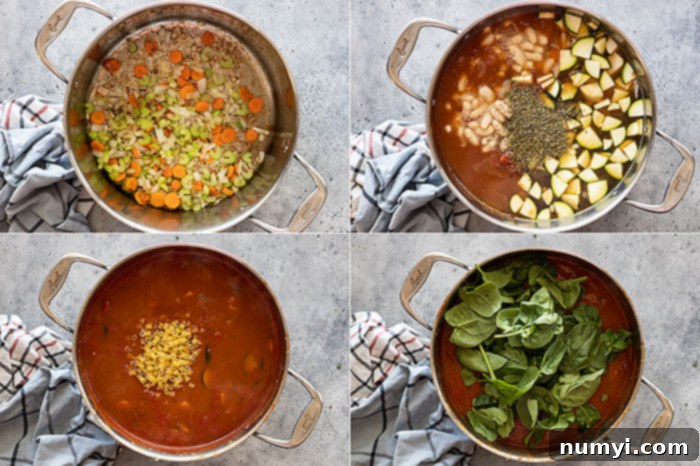
How To Make The Best Homemade Minestrone Soup: Step-by-Step Guide
Making this incredible minestrone is a straightforward process. Follow these steps for a perfect bowl every time:
1. MASTERING THE SOFFRITTO: Begin by heating your extra virgin olive oil in a large, heavy-bottomed pot or Dutch oven over medium heat. Add the diced onion, celery, and carrot. Sauté these vegetables gently, stirring occasionally, until the onion becomes translucent and softened, and the carrots begin to tenderize – this usually takes about 5-7 minutes. This step is crucial for building a deep flavor base. Next, stir in the minced garlic and cook for just another 30 seconds until fragrant. Be careful not to burn the garlic, as it can turn bitter very quickly.
2. SIMMERING THE SOUP BASE: Once your aromatic base is ready, add all the remaining ingredients to the pot EXCEPT for the pasta and fresh spinach. This includes your zucchini, potato, Italian seasoning, oregano, basil, crushed tomatoes, diced tomatoes, vegetable broth, and drained/rinsed cannellini beans. Bring the mixture to a gentle simmer, then reduce the heat to low, cover, and let it cook for about 15 minutes. This simmering time allows the flavors to meld beautifully and gives tougher vegetables like potatoes a head start in softening. If you prefer your zucchini to retain a bit more bite and not become overly soft, you can hold off on adding it until you add the pasta in the next step.
3. ADDING PASTA AND SPINACH: After the initial simmer, stir in your chosen small pasta shape. Continue to simmer the soup uncovered until the pasta is cooked al dente (tender yet firm to the bite). The exact cooking time will vary depending on the type and size of pasta you use, so check your package instructions and taste test as it cooks. Once the pasta is perfectly cooked and the vegetables are tender, remove the pot from the heat. Stir in the fresh spinach until it wilts into the hot soup – this happens quickly, usually within a minute or two. Serve your magnificent minestrone hot, garnished generously with freshly grated Parmesan cheese if desired, and perhaps a drizzle of good quality extra virgin olive oil.
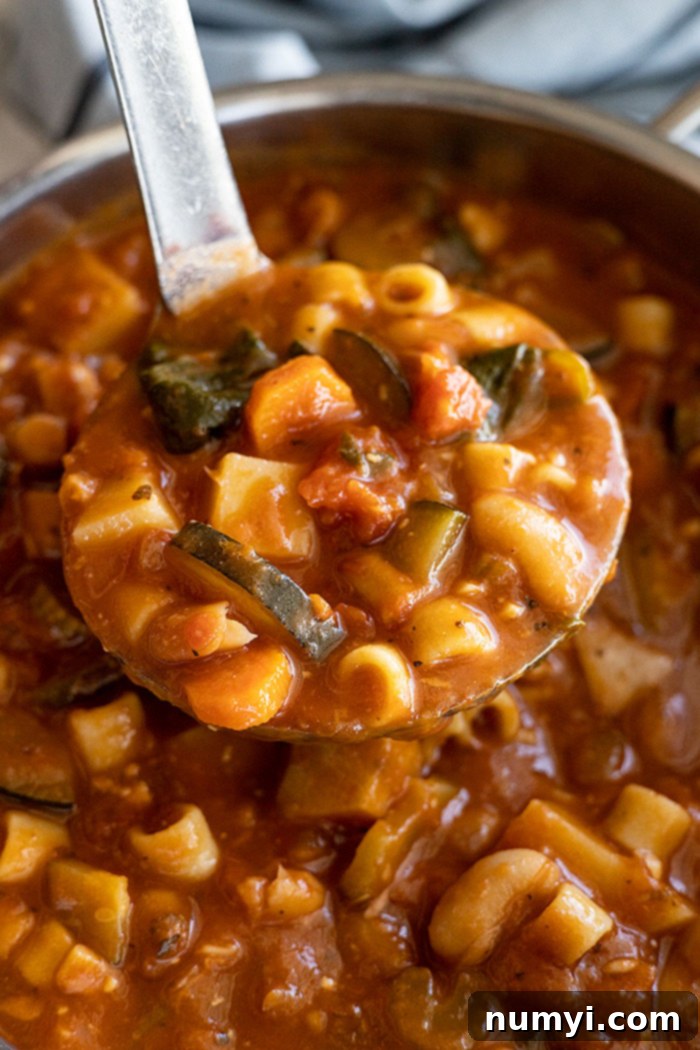
Frequently Asked Questions About Minestrone Soup
Absolutely! Minestrone soup freezes exceptionally well, making it a fantastic meal prep option. To freeze, first allow the soup to cool completely to room temperature. Then, pour it into freezer-safe containers or heavy-duty freezer bags, leaving a little headspace for expansion. Freeze for up to 3 months. When you’re ready to enjoy it, thaw the soup overnight in the refrigerator before reheating.
The best way to reheat minestrone soup is gently on the stovetop. Pour the desired amount into a saucepan and heat over medium-low heat, stirring frequently, until warmed through. Since pasta tends to absorb more liquid as it sits, your soup might thicken in the fridge. If it becomes too thick for your liking, simply add a splash of extra vegetable broth or water while reheating to achieve your preferred consistency. For individual servings, you can also reheat the soup in the microwave, stirring halfway through.
Proper storage is key to enjoying your homemade minestrone for days. Once the soup has cooled completely, transfer it to an airtight container. Store it in the refrigerator for 3-5 days. Be sure it’s fully cooled before sealing and refrigerating to maintain freshness and safety.
Small pasta shapes work best as they cook quickly and fit nicely on a spoon with the vegetables. Ditalini, small shells, elbow macaroni, orecchiette, or even small broken spaghetti are all excellent choices. The pasta also helps thicken the soup slightly as it releases starches during cooking.
While this recipe is crafted to be a delicious vegetarian option, you can certainly add meat if you prefer! Browned Italian sausage (mild or spicy), shredded cooked chicken, or even small pieces of cooked beef can be stirred in during the last 10-15 minutes of simmering. Adjust the broth type accordingly (e.g., use chicken broth if adding chicken).
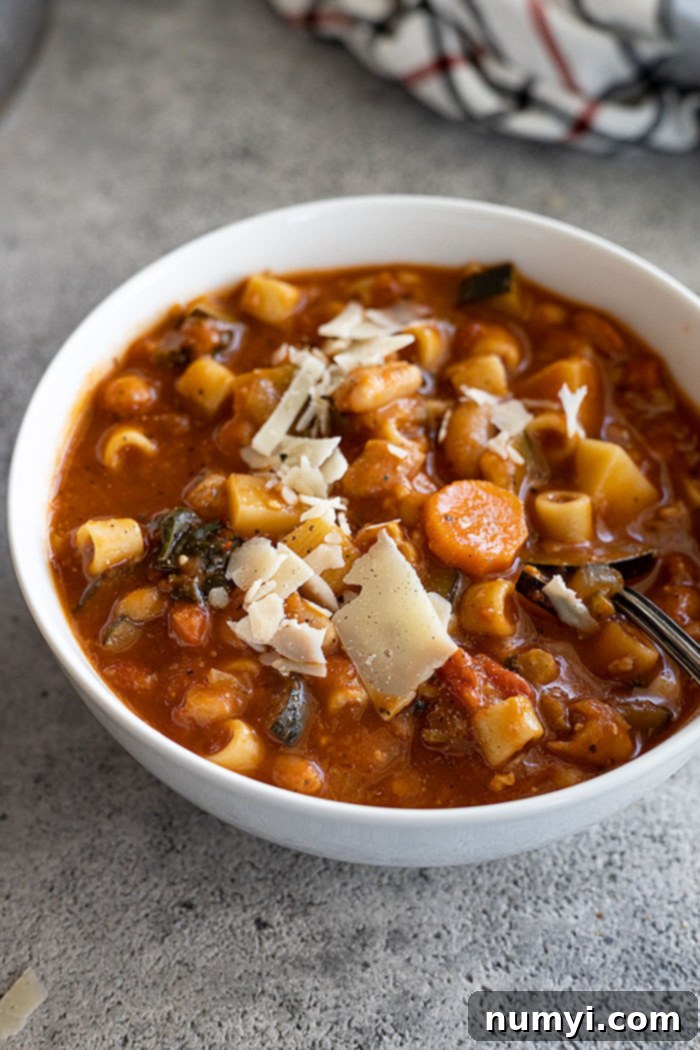
Delicious Variations to Customize Your Minestrone
One of the greatest joys of making minestrone is its incredible adaptability. This recipe is more of a guide, encouraging you to experiment and make it truly your own based on what you love and what you have available. Here are some fantastic ways to switch things up:
- VEGETABLE EXPLORATION: Don’t feel confined to the vegetables listed. Minestrone is a fantastic canvas for almost any vegetable. Consider adding sweet potatoes (diced small), hearty kale or collard greens (stir in with spinach), vibrant summer squash, crisp green beans, tender peas (add frozen peas in the last 5 minutes), bell peppers, or even corn. Remember that some root vegetables or denser greens may take longer to soften, so ensure they are cut into small, manageable pieces (no larger than 1/2 inch) to cook evenly.
- BROTH OPTIONS: While vegetable broth keeps this soup vegetarian, you can easily swap it for chicken broth or beef stock if you’re looking for a different depth of flavor or are not strictly vegetarian. Just ensure to adjust salt levels as different broths have varying sodium contents.
- BEAN BOOST: For those who prefer to cook with dried beans, you can absolutely replace the canned beans. Just remember that dried beans require pre-soaking and cooking ahead of time (either on the stovetop or in an Instant Pot/pressure cooker) until tender before adding them to the soup. You can use great northern beans, kidney beans, or even chickpeas for a delightful twist.
- PASTA ALTERNATIVES: If you’re catering to a gluten-free diet, simply use your favorite gluten-free pasta. Alternatively, for a different texture or to make the soup even heartier without pasta, you can replace the pasta with brown rice, quinoa, or quick-cooking barley. Or, for a low-carb version, simply increase the amount of beans and vegetables, omitting the pasta entirely.
- ADD A SPICE KICK: For those who enjoy a little heat, a pinch of red pepper flakes added with the garlic or a dash of hot sauce at serving time can elevate the flavor profile.
- FRESH HERB FINISH: While dried herbs provide excellent base flavor, a handful of fresh chopped parsley or basil stirred in right before serving adds brightness and a beautiful aroma.
Serving Suggestions for Your Perfect Minestrone Meal
This homemade minestrone soup is a complete meal in itself, but it truly shines when paired with a few simple accompaniments. For an authentic Italian experience, serve it with:
- Crusty Bread: A warm, crusty loaf of bread is essential for dipping into the rich, flavorful broth. It’s perfect for soaking up every last drop! For an elevated touch, try this incredible Rosemary Parmesan Bread – its herby, cheesy notes complement the soup beautifully.
- Simple Side Salad: A crisp, fresh green salad dressed with a light vinaigrette or your favorite dressing provides a refreshing contrast to the hearty soup. Our Homemade Ranch Dressing is a creamy and flavorful option that pairs surprisingly well!
- Garlic Bread or Crostini: Toasted garlic bread or small, crispy crostini brushed with olive oil and garlic add a wonderful crunch and extra flavor dimension.
- Extra Parmesan: Always offer extra grated Parmesan cheese at the table for guests to sprinkle on top of their bowls. A little extra cheese never hurts!
No matter how you choose to serve it, this homemade minestrone soup is sure to bring warmth and comfort to your table, proving that healthy, delicious meals can be easy to make and incredibly satisfying.
HUNGRY FOR MORE? Don’t miss out on our latest delicious recipes and cooking tips! Subscribe to my newsletter and follow along on Pinterest, Facebook, and Instagram for all my latest updates!
Minestrone Soup

Ingredients
- 2 tablespoons extra virgin olive oil
- 1 large onion, diced
- 2 stalks celery, diced
- 1 large carrot, diced
- 4 cloves garlic, minced
- 1 small zucchini, quartered and sliced
- 1 large potato, peeled, washed, and diced
- 1 teaspoon Italian seasoning
- 1 teaspoon dried oregano
- 1 teaspoon dried basil
- 1 (28 oz) (793g) can crushed tomatoes
- 2 (14.5 oz) (411g) cans petite diced tomatoes
- 6 cups low sodium vegetable broth
- 2 (15 oz) (425g) low sodium cannellini beans, drained and rinsed
- 1 cup (135g) ditalini pasta or other small pasta
- 2 cups (75g) spinach
Instructions
-
Heat the olive oil in a large pot over medium heat. Add the onion, celery, and carrot and cook until onion is softened. Stir in the garlic and cook for 30 seconds.
-
Add the rest of the vegetables, seasonings, canned tomatoes, broth, and beans. Simmer on low heat for 15 minutes. Stir in the pasta and simmer until pasta is al dente and vegetables are tender. Remove from heat and stir in the spinach. Garnish with parmesan cheese if desired.
Notes
- STORAGE: Store cooled soup in a sealed container in the refrigerator for 3-5 days.
- FREEZER FRIENDLY: Pour completely cooled soup into a freezer-safe container and freeze for up to 3 months. Thaw in the refrigerator overnight.
- Taste your soup and add salt and pepper as needed. If you feel the soup needs a little something still add a splash of red wine vinegar or a squeeze of fresh lemon. Both will brighten up the flavors of the soup.
- Be sure to read the post for lots of substitutions.
Nutrition
